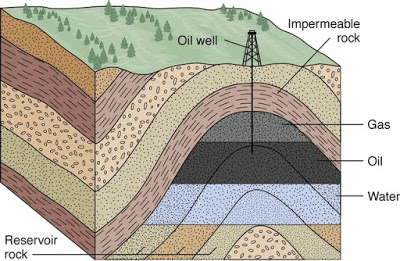Source rock

Source rocks are rocks that contain sufficient organic material to create hydrocarbons when subjected to heat and pressure over time.[2] Source rocks are usually shales or limestones (sedimentary rocks). To be a productive source rock, the rock needs time to mature (time to form the oil and/or gas) and the hydrocarbons need to be able to migrate to a reservoir or seep. Source rocks are usually a separate layer from the reservoir rock layers but occasionally they can be both source and reservoir. Source rocks are often offset from the reservoir, meaning that they are not directly below the reservoir but off to the side.[2]
As the source rock becomes more deeply buried under layers of sediment, the temperature begins to increase triggering geochemical reactions that convert the organic materials into hydrocarbons. Crude oil forms from 65 to 150 degrees Celsius. If the temperature goes over 150 degrees Celsius, natural gas can be formed (see Figure 2). This usually occurs at greater depths than oil formation. Marine rocks tend to form oil while terrestrial, or land, rocks tend to form gas.[2]

Once the hydrocarbons have formed, they migrate from the source rock. They are then either trapped in a reservoir or are "lost" during migration. "Lost" hydrocarbons escape from the Earth through seeping (essentially they leak out of the ground) or disperse throughout the Earth's surface instead of collecting in one spot. It is estimated that only 10% of the oil and gas that has formed has been trapped. Oil and gas reservoirs typically form in traps. There are a few types of traps: anticlinal, fault, stratigraphic, and reef and/or salt traps. While the exact mechanics of each trap type differs, they all trap oil and gas in a reservoir by having an impermeable cap rock layer and by sealing the bottom of the reservoir with water (oil and gas are less dense than water) or another impermeable rock layer.[2]
For Further Reading
References
- ↑ Source unknown. Please contact us if you know this image's source.
- ↑ 2.0 2.1 2.2 2.3 Hyne, N., 2012. "Nontechnical Guide to Petroleum Geology, Exploration, Drilling, and Production", Tulsa: PennWell Corporation.
- ↑ Steven Earle, 2012. "20.3 Fossil Fuels", Accessed Dec.8, 2018. [Online] Available from:https://opentextbc.ca/geology/chapter/20-3-fossil-fuels/

